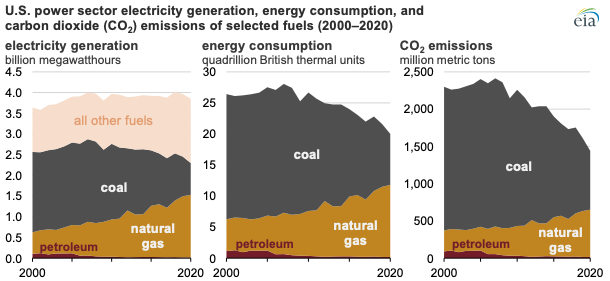Based on data in EIA’s Monthly Energy Review, energy-related carbon dioxide (CO2) emissions decreased by 11% in the United States in 2020 primarily because of the effects of the COVID-19 pandemic and related restrictions. U.S. energy-related CO2 emissions fell in every end-use sector for the first time since 2012.

Within the U.S. power sector, emissions from coal declined the most, at 19%. Natural gas-related CO2 rose by 3%. In 2020, as fossil fuel generation declined, generation from renewables continued to grow. Generation from wind and solar together increased by 17% in 2020. This shift in the United States toward renewable generation sources helped to lower the carbon emissions per unit of electricity generated, also known as carbon intensity. In our end-use sector CO2 emissions series, emissions from the power sector are distributed to each sector based on the sector’s share of total electricity consumption.

Commercial: CO2 emissions associated with energy use fell by 12% in the commercial sector in 2020. Part of this drop in emissions was due to pandemic restrictions. Because electricity is a large source of energy for the commercial sector, the declining carbon intensity of electric power also contributed to declining CO2 emissions from commercial activity. Emissions from commercial electricity use fell by 13%. Commercial petroleum and natural gas emissions fell by 13% and 11%, respectively.
Industrial: Energy-related CO2 emissions fell by 8% in the industrial sector in 2020. Most of this decline came from a slowing of manufacturing operations because of responses to the COVID-19 pandemic. Emissions from coal fell by 15%, from electricity by 15%, from petroleum by 8%, and from natural gas by 2%.
Residential: CO2 emissions associated with energy use in the residential sector declined by 6% in 2020. Much of the reduction in residential emissions stemmed from declining carbon intensity in the power sector as opposed to declining energy consumption. Although the number of people working from home increased during the pandemic, 2020 also had relatively mild winter and summer weather. These opposing consumption effects led to only a 1% decrease in residential energy consumption. Residential petroleum emissions fell by 11%, natural gas by 7%, and electricity by 5%.
Principal contributors: Kevin Nakolan, Perry Lindstrom










